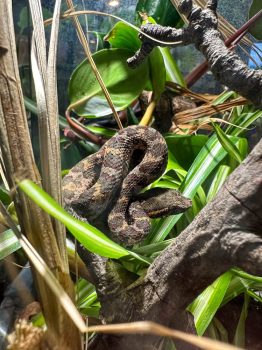Flat Nose Viper
Common Name: Flat Nose Viper
Scientific Name: Craspedocephalus puniceus
Names: N/A
Locations: Whitby


Diet
Flat Nose Vipers are carnivorous and primarily feed on small mammals, birds, lizards, and amphibians. They use their venom to subdue prey before consumption.
Average lifespan
In the wild, they typically live around 10 to 15 years.
Size
Adults usually measure approximately 60 to 90 centimeters (2 to 3 feet) in total length.
Weight
Adult Flat Nose Vipers generally weigh between 300 to 600 grams, with variations depending on individual size and condition.
About
The Flat Nose Viper is a venomous pit viper native to tropical regions of Southeast Asia. It is recognized by its uniquely flattened snout and distinct scale pattern, which provide effective camouflage in its forest floor habitat. This species is primarily terrestrial, relying on stealth and rapid strikes to capture prey.
Size and behavior
With a modest size compared to some other vipers, the Flat Nose Viper uses its flattened, broad snout to blend into leaf litter and underbrush. It is mainly nocturnal, spending its nights hunting and its days resting in concealed areas. Typically solitary and territorial, it employs an ambush strategy to capture unsuspecting prey.
Diet and nutrition
As an opportunistic predator, the Flat Nose Viper’s diet consists of various small animals that supply the proteins and nutrients needed for energy and growth. Its method of envenomation ensures that prey is quickly immobilized, making feeding efficient even in the low-light conditions of its forest environment.
Conservation status
While specific population data for Flat Nose Vipers may be limited, they are generally not considered critically endangered. However, like many forest-dependent species, they could be affected by habitat loss and deforestation. Current assessments typically categorize them as Least Concern or Data Deficient, depending on the region and available research.
Fun fact
The Flat Nose Viper gets its name from its distinctly broad and flattened snout—a feature that not only aids in camouflage but may also enhance its ability to detect vibrations on the forest floor, helping it to ambush prey effectively.
Call or visit your local Reptilia Facility to learn how you can adopt one of these amazing reptiles.










